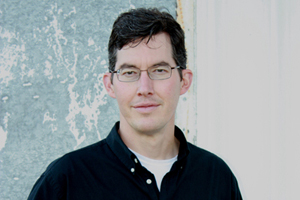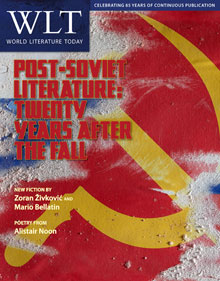
Shortly after the collapse of the Soviet Union in 1991, Russian author Yevgeni Popov (b. 1946) offered a vivid description of the cultural climate he and fellow writers had lived through during the prior seven decades: "At the very word writer a strange smile parted the cast-iron lips of that reinforced concrete structure called the USSR. . . . The patriarchal state raged at its writers; it deprived them of their daily bread, it put them in prisons and psychiatric wards, it drove them abroad, and, finally, it simply killed them when they dared to step beyond the bounds of the shaman's circle drawn by the Communist Party" ("The Silhouette of Truth," WLT, Winter 1993). Writers in the Soviet Union, according to Popov, had little choice but to "cheerfully march along the highway to a communism glistening like a polished jackboot." Mindful of his illustrious predecessors who had lived through, but not always survived, the Soviet era, Popov expressed both elation at the prospect of hauling himself "out from under the ruins" of communism yet also the burden of having inherited a cultural landscape littered with catastrophe.
Of course, the jackboot of communism didn't always apply the same amount of pressure on the throats of Soviet writers. Periods of relative freedom of expression—notably during the early years of Communist rule (1922–29), in the thaw following the death of Stalin (1953–63), and during the glasnost era (1985–91)—marked brief reprieves from the constant pressure of totalitarian control. Indeed, during the 1920s and '30s, writers and artists throughout the world saw in the utopia of socialism a counternarrative to the inequalities of capitalist society and a bulwark against the rise of fascism. Yet many in the West refused to believe that the dream had turned into a nightmare by the mid-1930s, so pervasive was their enthusiasm for the Soviet experiment—even after some seven million peasants died during the famine caused by the party's policies of forced collectivization (1932–33), when over a thousand opponents of the regime were shot every day during Stalin's Great Purge of 1936–38, and as millions more perished in the camps of the gulag system (1930–60).
Even in 1935, following the worst years of the famine, Andrew J. Steiger's article on the revolution in Soviet poetry, which appeared in the Summer 1935 issue of Books Abroad (the precursor of WLT), reads like party propaganda. After beginning the article with a hagiographic eulogy to the recently deceased poet Eduard Bagritsky, the author idolizes "platform orators" who "roared, trumpeted, and disgorged" their poems on the square. Poet-comrades, like lumpen literati, were obliged to place their work in service to the revolution: "During the period of Revolutionary change . . . the poet had to come out of his study," Steiger writes. "People . . . were on the streets, they filed through the squares with banners, they put machine-guns on barricades. . . . The Revolution forced the poets out of their solitude, made them spokesmen of the people." Even though Bagritsky began to covertly criticize the Stalinist regime toward the end of his career, nothing could diminish his apotheosis in Steiger's eyes. During some of the darkest decades of the Soviet era, the grand narrative had little tolerance for bothersome truths.
Today, twenty years after the fall of the Soviet regime, a new generation of writers—Pelevin, Sorokin, Tolstaia, Ulitskaia, Shishkin, Bykov, and many others—is still navigating the ruins of Soviet history, even as it moves beyond that shattered legacy and occupies itself with twenty-first-century concerns. For the writers included in this issue, the waterfall of Truth, which Solzhenitsyn envisioned cascading through the chasms of Russian history, has divided into a thousand tributaries, and truth itself is no longer "roared, trumpeted, and disgorged" but rather continually refracted through the prism of the past—and sometimes blinded by the glare of the present. As Yevgeni Popov wrote nearly twenty years ago, "The writer always composes a false and subjective picture of reality, but what is an authentic picture if not an average of all the false ones? The realia of life have no distinct outline, and it is only in the multitude of mutually exclusive representations, superimposed on one another, that the silhouette of truth begins to show through." While perhaps "false and subjective," these pictures of reality provide glimmers of truth behind the cascade of history.
Editorial note: Special thanks to our contributing editor and colleague Emily Johnson, who proposed the idea for this special section nearly two years ago and whose guidance has been instrumental in putting it together. Her introductory note, which puts the remarkable changes of the past twenty years into perspective, begins the section proper on page 32 of the print or digital edition.


